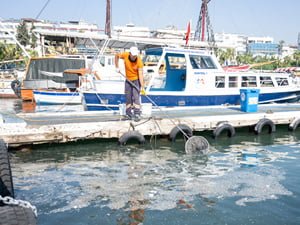Mersin Metropolitan Municipality took action to clean microplastics in the sea.
Teams from the Marine Services and Inspection Branch Directorate of Mersin Metropolitan Municipality Environmental Protection and Control Department took action to clean microplastics in the sea. Teams, which have been cleaning larger solid wastes for a long time with sea vacuum cleaners and fiber boats, started working with appropriate equipment to clean micro-sized wastes. Teams that create a porous net system collect microplastics from the sea surface every day.
Teams that want to clean the microplastics in the seas, which have increased more than expected in recent years and threaten the marine ecosystem, have started working with appropriate equipment. While the teams clean from the shore thanks to the fine-textured porous nets they place at the end of the cleaning apparatus, they sometimes do the same cleaning by sailing on boats. Nets that can collect very tiny microplastics also minimize the risk of marine creatures swallowing microplastics.
Teymur: “Microplastics reach humans through the food chain.”
Captain Pelin Teymur, who works at Mersin Metropolitan Municipality Environmental Protection and Control Department, Marine Services and Inspection Branch Directorate, said, “The main source of marine pollution in the Mediterranean is 85 percent land-based and 15 percent ship-based. The most intense type of pollution we encounter in our seas, including land-based and ship-based pollution, is plastic pollution. “According to scientific research, approximately 95 percent of the waste in the Mediterranean is plastic waste,” he said.
Stating that the transformation period of plastic waste in nature is very long; Stating that these plastics harm nature, people and sea creatures, Teymur said, “Plastic waste constitutes a dangerous type of pollution that reaches sea creatures through the food chain, from sea creatures to humans and human blood. “Plastics smaller than 5 millimeters are called microplastics and their cleaning requires serious work,” he said.
“We created a porous net system that even very small plastics cannot pass through.”
Emphasizing that it is very difficult to clean microplastics, especially to collect them from the sea surface, Teymur continued as follows:
“We carry out various research and development with our colleagues. We created a porous net system by hand, so that even very small plastics cannot pass through. Our staff collects garbage from the sea every day with this net from land. At the same time, our marine vehicle regularly collects daily garbage on the sea surface. We see this in the garbage: “Large pieces can be removed with a sea vacuum cleaner, but since very small pieces escape, the best system is the net system.”
“We are working to integrate the system into marine vehicles as well.”
Adding that the majority of the garbage they collected from the sea surface was plastic waste, Teymur said, “For example, we collected a ton of garbage this week and approximately 800 kilograms of one ton of garbage was plastic waste.
In addition to the file system, we are working on an automation system that we can integrate into marine vehicles with our colleagues from the technical team working at the Maritime Services Branch Directorate. We plan to develop this and use it in our seas in the coming days.
We also demand the following from our sensitive citizens; We cannot finish it by picking up the garbage. “To prevent the garbage from reaching the sea or nature, please throw your plastic waste in recycling bins, try to use it less, or support us by separating the garbage at its source,” he said.
The opinions expressed herein are the author’s and not necessarily those of News2Sea.
#sea #Mersin #cleared #microplastics
